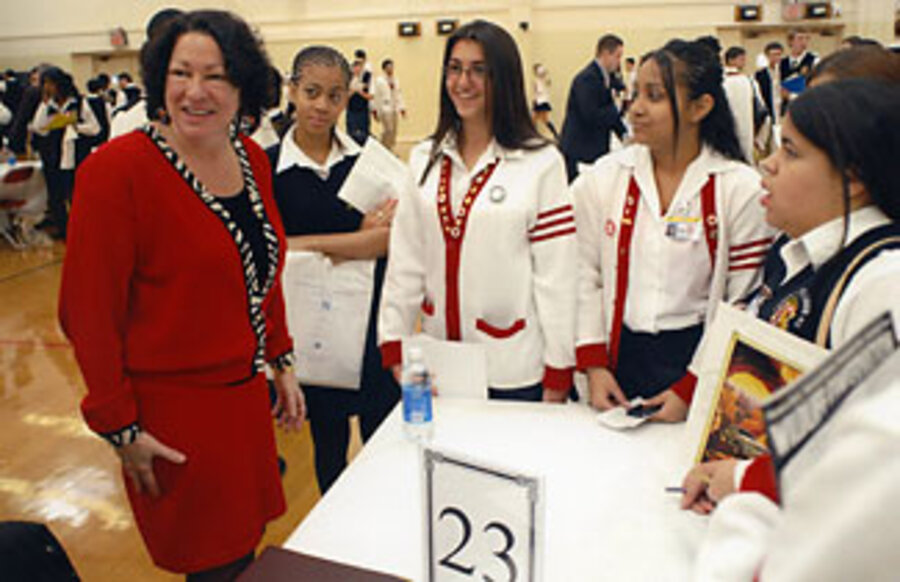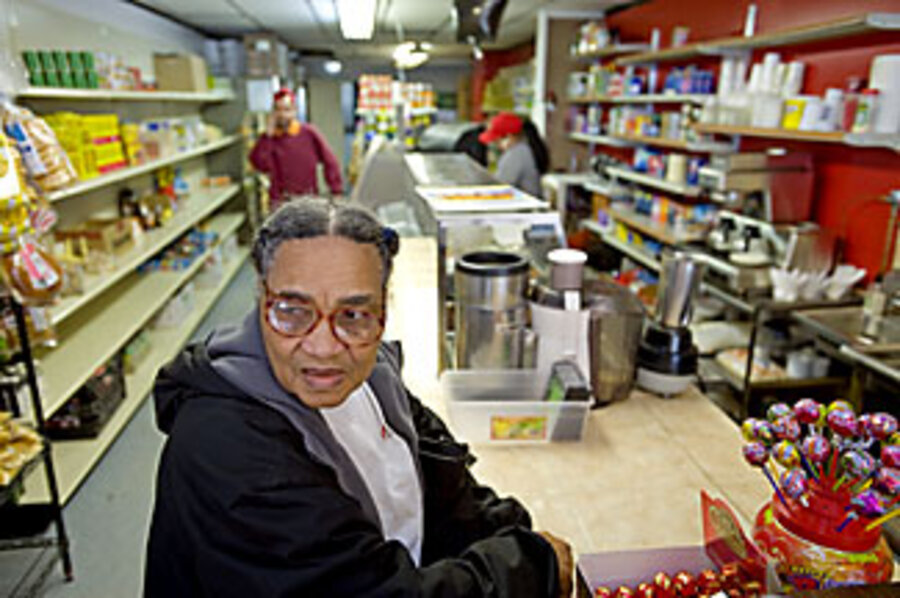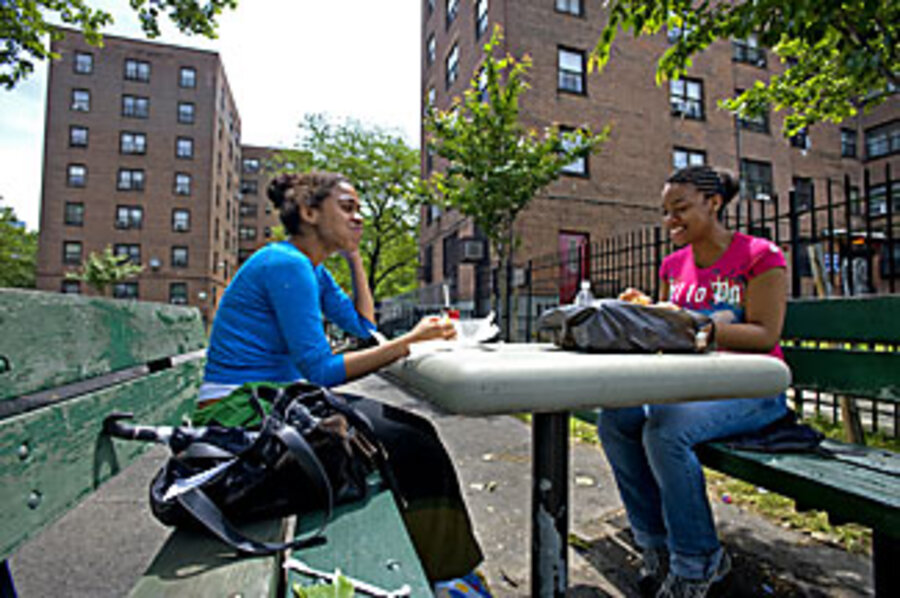Sotomayor a racist? Hardly, South Bronx says
Loading...
| New York
As Supreme Court nominee Sonia Sotomayor makes the rounds meeting key senators on Capitol Hill this week, the South Bronx where she was raised and much of the city she still calls home are rippling with pride – orgullo, in Spanish.
At the same time, people here along Bruckner Boulevard bristle at the attacks against Judge Sotomayor by conservatives like Newt Gingrich and Rush Limbaugh, who have called her a racist. While each has toned down his criticism in the past day, many in this multicultural and predominantly Democratic borough believe the attacks themselves show a lack of understanding about how growing up in a "minority-majority" neighborhood shapes one's view of the world.
At the Caribe Fruits and Vegetables market on Westchester Avenue, where guavas and plantains sit next to a cooler full of Coke, Luis Irizarry calls Sotomayor "one of the best."
"We Puerto Ricans are very proud," says the retired postal worker, who came from Puerto Rico 35 years ago. "She grew up right here. What she's going to do for the Latin people is going to be a big surprise: Latin people will feel differently about themselves because she's on the court."
At the community center of the Bronxdale Houses, the project where Sotomayor grew up, college junior Derrick Hewley of Dominican and African-American descent puts it this way:
"It feels like if anyone from the Bronx can attain such a high position, it shows us that we can all do that," he says. "It gives me hope. I'm excited to be part of the Bronx and representing the Bronx."
This is a community that is so racially and ethnically mixed, he says, that "nobody up here ever says, 'You're Puerto Rican or you're Dominican so I'm not going to hang with you,' " he says. "We get to know the person first."
There is also a strong sense among some here that the type of perspective in the Bronx is still missing in some crucial parts of mainstream American culture. That's why Sotomayor's nomination is seen as such a huge step.
"She will bring compassion," says Jose Mulero, who came to the United States as a teenager 50 years ago. "I'm not saying white people can't be compassionate or that they discriminate, necessarily, but white people think often of themselves. Latin people, minorities, we think of us all together."
That might sound to some exactly like the kind of reverse racism that critics have charged Sotomayor with. She said in a speech in 2001: "I would hope that a wise Latina woman with the richness of her experiences would more often than not reach a better conclusion than a white male who hasn't lived that life." Through the White House, Sotomayor has made clear that was a poor choice of words.
But in that same speech, she also talked about the tension in America between being "a melting pot and a salad bowl."
"We are a nation that takes pride in our ethnic diversity, recognizing its importance in shaping our society and in adding richness to its existence," she said. "Yet we simultaneously insist that we can and must function and live in a race and colorblind way that ignore these very differences that in other contexts we laud."
For many young people in this neighborhood, those differences are still very much apparent – as are some of the vestiges of distrust between races and socioeconomic groups. Diane Biswas is a high school graduate with some college course work who grew up in the neighborhood surrounding the Bronxdale Houses. She's also a single mother. When she was applying for a job in an upscale store in Manhattan, she felt people were suspicious just because she lived in the South Bronx.
"They asked, 'Is it going to be problem for you to get down here?' " she says. "But the way they asked I knew exactly what they meant: 'Is she a ghetto girl coming from the Bronx to work here and corrupt us?' I know they didn't mean to sound that way, but it was there."
Because of such experiences, many New Yorkers believe that the gist of Sotomayor's controversial comment was on target, if poorly worded. As the first Latina on the court, they say, she will bring a new perspective.
"It's very much like the first time Thurgood Marshall [an African-American] was nominated: He brought with him a sense of this country that had been missing from the Supreme Court," says Robert Ramirez, incoming president of the Puerto Rican Bar Association in New York. "That was not exclusive of his intimate knowledge of the Constitution. It simply means that he was able to add his unique perspective and a history that may not have always been given voice to on the court. Sotomayor can do that, too, not because the other justices may not have wanted to, but just that it's impossible to have that unique perspective unless you've been raised in the Bronx where you've experienced the culture and flavor and challenge of becoming an accomplished academic performer here."
Growing up with two languages and two cultures, as well as moving between two very different economic strata – think South Bronx and Yale – creates a unique kind of dexterity, say some Latina scholars.
"I always talk about my life as jumping double Dutch – two ropes going in opposite directions and jumping really, really hard and trying not to stop either of them," says Esmeralda Santiago, author of "When I Was Puerto Rican." "Sotomayor is a very good example of that, of somebody who is on both sides and can see both sides and has the intellect to be objective about both sides. I think that's something that's very rare and unusual."
Back on Capitol Hill, though, Republican senators are scouring her record to see if there's any indication that Sotomayor's controversial comment – the "wise Latina woman" one – has influenced her judicial temperament or understanding of the law. On Fox News earlier this week, Sen. Lindsey Graham (R) of South Carolina expressed his reservations about her nomination this way: "That statement is not about talking about her life experiences," he said. "It's getting from her life experiences a superiority based on those experiences versus somebody else in society. And I don't want that kind of person being a judge in my case."







